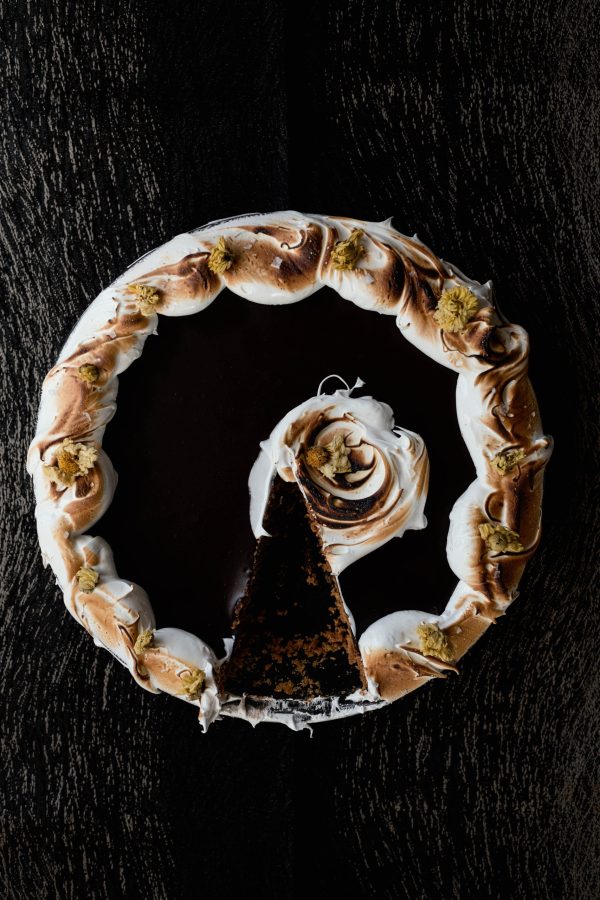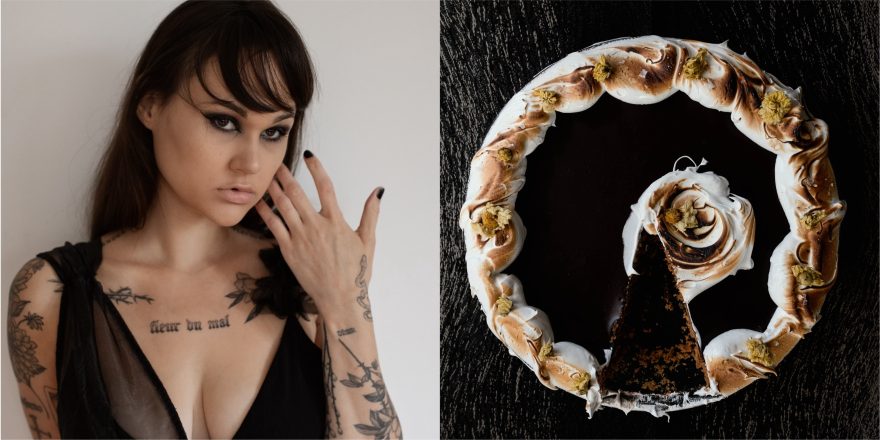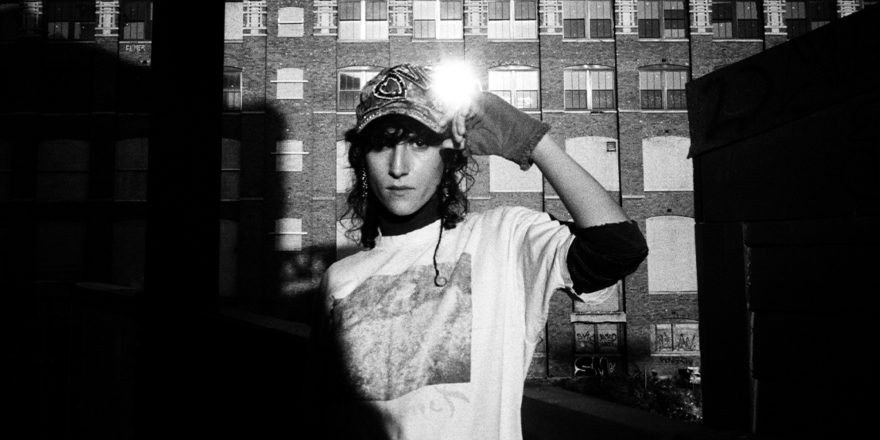Thalia Ho — the author of the cookbook Wild Sweetness and the blog Butter & Brioche, loves Nick Cave, Ethel Cain, and FKA Twigs. This makes complete sense if you’ve ever tried one of her moody and richly nuanced recipes. For the latest issue of the Talkhouse Reader, she told us how her work in the kitchen and her favorite music feed each other — and kindly shared her recipe for S’mores Pie, from Wild Sweetness. The Food Issue is available now digitally and in print.
— Annie Fell, Editor-in-chief, Talkhouse Music
It’s the story of my life, honestly, with my father and his music. It was always there. He played guitar in heavy metal bands — and he still plays in one. My mom, as well, was always involved in the arts. She directed a lot for the stage, so I grew up in the wings of her performances. I got introduced to some adult ways of seeing and feeling early on, and it definitely informed my taste, and how I move through this world.
The first show I ever went to was a Chris Isaak show. I was young and appalled. All of my little girlfriends were going to P!nk or Hilary Duff or Rihanna, and I wasn’t allowed to go. I just didn’t understand the appeal of this old man standing up on the stage in a disco ball mirrored suit, serenading the audience… But now I’m very grateful for that experience. My dad introduced me to a lot of the classics, and they have a form of poetry that transcends everything that they do. The music that I was into early on was very much about hunger and longing, various forms of desire and rage, and that’s what I feel with food. It’s all the same ballad, in my eyes. I have a lot of strangely curated playlists now, and sometimes one of those early songs will sneak in, and when I’m creating in the kitchen, it’ll influence what ends up on the plate.
So much of this work is subconscious. I find that, for me, everything in this world is about vibration. And that really is the way that I look at my food — I’m not just making something that looks pretty or tastes delicious. I want to see how it interacts with you on a physical, as well as spiritual level. When I’m writing my recipes, I’m not just writing for myself; I’m writing for someone else, and I think about their story, how they’re going to incorporate it into their own life. So, I play around with flavor, technique, methodology. Sometimes, I’ll write a step and it may not be the easiest way of doing something, but I’ll write it in a way so that you’ll have a certain experience while doing it, and that contributes to the final dessert. It’s about path and progression, and it doesn’t just end with a mouthful — it evolves. And that’s what music does as well. They’re very similar mediums.
I categorize the artists I really love on a spectrum of vibration. The lower vibration are those kind of dark, flowery, esoteric darlings — [listening to them,] it’s like I imagine myself emerging from a sunken tomb. Artists, like Zola Jesus, Sevdaliza, Emma Ruth Rundle, Chelsea Wolfe, Ethel Cain, and Nicole Dollenganger, hit so deep in my body. And then on the higher end of the spectrum, I think of Florence Welch, FKA Twigs, Jeff Buckley, Thom Yorke, Leonard Cohen, Nick Cave… I play around with those same shades of light and dark in my food. You have to have that polarity.
Listening to certain artists helps, but again, so much of this work is subconscious that I don’t know how it happens. I don’t look at other chefs, I don’t really read other cookbooks. I go on Instagram and post my stuff then get off. I find engaging in someone else’s art limiting for my own. Music is different. It’s really one of the only forms [while engaging with other art] where it doesn’t feel like I’m taking from someone else; I’m transforming.
Does food move me in the same way as music? That’s a tricky question. In the past, the answer would be yes, I was infatuated with it. But where I’m at now, I’ve removed that attachment. I almost feel like an impartial observer. I can see the beauty, structure and technique and process in food, things like that, but it doesn’t hit so deep in my being. I like to think that my work is stronger because of that refinement. No one can remain engaged in their own art form for too long, and if they do, it’s deadly.
Food and music really are, in my opinion, quite the same thing. It’s all about creation, connection, and hunger. What it means to be human and meet our human needs. I don’t think I could do one without the other, that’s for sure.
As told to Annie Fell.

S’mores Pie
For the crust:
1 cup (130 g) graham cracker crumbs
2 tablespoons granulated sugar
¼ teaspoon salt
¼ cup + 2 teaspoons (70 g) unsalted butter
For the filling:
1 ½ cups (255 g) dark chocolate, finely chopped
1 cup + 2 ½ tablespoons (280 ml) heavy cream
1/3 cup (80 ml) whole milk
2 large eggs
1 teaspoon vanilla extract
For the meringue:
2 large egg whites
¾ cup (150 g) granulated sugar
A handful of culinary-grade dried chrysanthemum flowers (optional)
Pre-heat the oven to 350 F (180 C). Set a 9-inch (23-cm) pie dish onto a baking sheet.
To make the crust, stir together the graham cracker crumbs, sugar, and salt.
Put the butter into a deep saucepan. Heat, stirring often, until melted. Turn the heat to medium-high and continue to cook, swirling the pan often but not stirring, until a deep-amber-hued liquid has formed. It will foam, hiss, and crackle, but should subside as it nears done. Pour into the crumbs, stirring until everything is evenly moistened, then tip into the pie dish. Use the back of a spoon to press the crust evenly into the base and up the sides.
Bake for 10 to 12 minutes, until golden brown. Set aside to cool, then lower the oven temperature to 325 F (160 C).
Next, make the filling. Place the chocolate in a large bowl and set it aside but near the space where you’ll be working. Pour the cream and milk into a deep saucepan. Bring to a simmer over medium heat, then remove, and stream it into the bowl with the chocolate. Let stand for a minute to acclimatize, then whisk until smooth. Add the eggs, one at a time, whisking well to incorporate each addition, then mix in the vanilla. Strain through a fine-mesh sieve into the crust.
Bake for 25 to 30 minutes, rotating halfway through, until just set. It should be puffed and have a slight wiggle too. Let cool to room temperature before topping with meringue.
To make the meringue, put the egg whites and sugar into the bowl of a stand mixer fitted with the whisk attachment. Set over a saucepan filled with a few inches of barely simmering water. Do not let the base of the bowl touch the water below. Heat, whisking often, until it reaches 160 F (71 C) on a candy thermometer. The sugar should be dissolved and the mixture hot to the touch. Set the bowl onto the stand mixer. Whisk on high speed until thick and glossy, about 5 minutes.
Swoop the meringue over the top of the pie, using the back of a spoon to swirl it out, then singe it with a blow torch, carefully. You could use a broiler here instead – just make sure to remove the pie as soon as the meringue has browned to prevent the filling from overcooking. Adorn with dried chrysanthemums, if using.
The pie is best eaten on the day of making but can be kept in the refrigerator for up to three days.
— Thalia Ho





